Abstract
Metamaterial absorbers have garnered significant interest due to their unique electromagnetic properties, which facilitate the efficient absorption of electromagnetic radiation in a specific frequency range or multiple frequency ranges. The metamaterial absorbers are designed based on artificially engineered structures that enable tailored absorption properties. These structures might include multiple resonances or incorporate electrical resistive components to achieve broadband absorption. This review paper provides a comprehensive analysis of the progress made in the field of the bandwidth of metamaterial absorbers, encompassing the underlying design principles, key performance characteristics, diverse applications, and perspectives for further research. The paper draws to a conclusion by outlining the potential future directions for further advancements in this exciting area of research, and highlighting the challenges that need to be addressed for the widespread adoption of metamaterial absorbers.
1. Introduction
Metamaterials have emerged as a class of advanced materials that have made significant contributions to the ongoing progress in science and technology [1]. These materials are artificially-engineered, comprising elemental unit cells with dimensions smaller than the operating wavelength, arranged periodically [2]. The constituent elements of metamaterial structures exhibit distinct electrical and magnetic resonance properties within specific frequency ranges [3]. Consequently, within these resonant frequency ranges, metamaterials manifest extraordinary electromagnetic characteristics which are not obtained with natural materials. Examples of such unique properties include negative refractive index [4], inverse Doppler effect [5], cloaking [6], and electromagnetically-induced transparency (EIT) [7]. The ability to manipulate the resonance properties of each element in the metamaterial structure or to modify the interconnections between these elements allows us precise control over the resultant properties of metamaterial [8,9,10,11]. This facilitates the tailoring of the material’s behavior according to the specific requirements and desires of the designer. By strategically adjusting the resonance properties or modifying the structural arrangement, the metamaterials can be engineered to exhibit the desired electromagnetic responses, paving the way for innovative applications in various fields of science and technology [12,13,14].
Metamaterials have garnered significant attention due to their unique and promising properties, one of which is their capability to exhibit the perfect absorption of electromagnetic waves [15]. This intriguing property was demonstrated first by Landy et al., wherein the metamaterial structure was able to absorb electromagnetic waves with a near-perfect efficiency, exhibiting minimal transmission, reflection, and scattering [16]. The unique properties of metamaterial absorbers have led to their adoption in various applications. For instance, in the field of sensing, metamaterial absorbers have been utilized to develop highly-sensitive sensors capable of detecting tiny changes in the environment [17]. In energy harvesting, these absorbers have been employed to capture and convert electromagnetic energy into electrical energy [18]. Moreover, they have also been utilized to develop high-performance bolometers and photo-detectors, with potential applications in imaging and sensing technologies [19,20]. The metamaterial absorbers are essentially ultrathin structures with dimensions smaller than one-tenth of the operating wavelength [21]. These structures are lightweight and highly flexible, making them easily integrated into existing electronic systems and devices [22,23]. Additionally, the fabrication process for metamaterial absorbers is highly versatile, allowing us to produce structures with varying shapes, sizes and properties [24,25,26,27]. As a result, these absorbers can be tailored to suit the specific application requirements [28].
The initial research on metamaterial absorbers focused on investigating the capability to perfectly absorb electromagnetic waves at their resonant wavelength [29]. The resonant wavelength could span from the MHz to THz range [30,31]. However, the limitations of a single absorption peak led to the proposal of metamaterial structures with multiple absorption peaks across different frequency ranges [32]. For instance, Kim et al. introduced a metallic-patch structure that enabled dual absorption [33], while Nam et al. utilized near-field coupling and integrated graphene inks to fabricate absorption structures with multiple peaks [34]. To broaden further the absorption frequency range, complex structures were incorporated into the design of metamaterials. These included the use of multilayer structures to achieve broadband absorption, the use of special materials with high absorption properties, and the integration of electric components to achieve impedance matching [35,36,37]. By implementing these strategies, the absorption band of metamaterials can be expanded significantly, allowing for a wider range of electromagnetic waves to be absorbed [38].
Currently, considerable attention has been paid to the investigation on broadband metamaterial absorbers, due to their advancements and advantages over the single- and multiple-peak ones [39]. These studies encompass the utilization of 2D structures on a planar surface, as well as 3D ones composed of multiple stacked layers forming cuboid configurations [40]. Various methodologies have been employed to achieve the optimal absorption of electromagnetic waves with diverse polarizations [41]. Additionally, the stability of metamaterial absorbers designed for a wide absorption angle was also considered [42]. Two crucial characteristics, namely the polarization insensitivity and wide-angle incidence, play a vital role in enhancing the practicality of metamaterial absorbers. By incorporating these properties, the versatility and applicability of metamaterial absorbers can be enhanced significantly [43].
We have been highly motivated by the recent progress made in this field of research, and deeply interested in the continuous advancement of metamaterial absorbers. In light of these achievements, we are undertaking a comprehensive review on the contributions by the scientific community to the study of the bandwidth of metamaterial absorbers. Our aim is to present a coherent overview of the key issues regarding this topic, which is organized in a structured and systematic manner: (i) Introduction, (ii) The Principles of the Metamaterial Absorbers in Controlling Single-Peak/Multiple-Peaks/Tailored-Band/Broadband, (iii) Design Strategies for the Bandwidth of Metamaterial Absorbers, (iv) Broadband Metamaterial Absorber Properties: Polarization Insensitivity and Wide Incident Angle, (v) Applications, and (vi) Conclusions and Future Perspectives.
2. The Principles of the Metamaterial Absorbers in Controlling Single-Peak/Multiple-Peaks/Tailored-Band/Broadband
2.1. Interference Theory
Interference theory is a widely accepted method for determining the absorption properties of metamaterial absorbers. This approach relies on the accumulation of reflections between the top metallic layer and the bottom metallic plate of the absorber [44]. Specifically, when the wave directly reflected on the resonator surface interferes destructively with that from multiple reflections, the wave is trapped within the metamaterial structure, leading to a high absorption. This phenomenon results from the constructive and destructive interference of waves, which can be explained by the interference model presented in Figure 1. The model illustrates how the incident wave is reflected off the top metallic layer, creating a reflected wave that interferes with the incident wave. The interference between these waves can be either constructive or destructive, depending on the distance between the top layer and the bottom metallic plate. When the distance is such that destructive interference occurs, it leads to the absorption of waves within the metamaterial structure. By understanding this physical mechanism, researchers can design and optimize the metamaterial absorbers for various applications, including sensing, imaging, and energy harvesting.
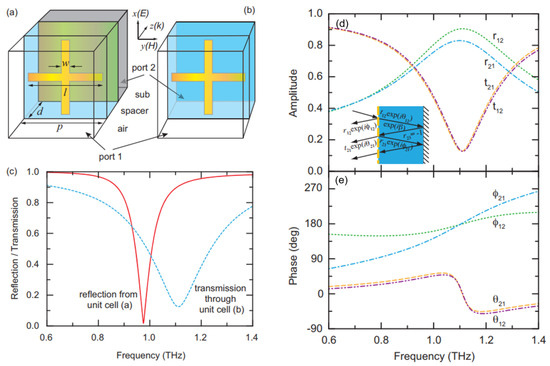
Figure 1.
(a) Schematic of the unit cell for a metamaterial absorber, which is repeated in the x and y directions, forming a square array with a periodicity p. (b) Unit cell used to obtain the reflection and transmission coefficients at the air–spacer interface with a cross-resonator array. (c) Solid red curve is the reflection |S11| from unit cell (a) of the metamaterial absorber, and the dashed blue curve is the resonant transmission |S21| through the cross resonator array shown in unit cell (b). (d) Amplitude and (e) phase of the reflection and transmission coefficients at the air–spacer interface with the cross-resonator array, obtained by the numerical simulation based on the unit cell shown in (b). Inset: Multiple reflections and the interference model of the metamaterial absorber, where the cross-resonator array is indicated by the dashed line at the air–spacer interface [44].
2.2. Impedance Matching Theory
Metamaterials are distinguished by their complex electric permittivity (ε = ε1 + iε2) and magnetic permeability (μ = μ1 + iμ2). By manipulating the resonance of ε and μ independently, absorption can be achieved for both electric and magnetic fields. Additionally, when ε and μ are matched properly, a metamaterial absorber can be impedance-matched to the free space, effectively minimizing the reflection of waves [16]. The absorption characteristics of metamaterial absorbers, specifically, their ability to achieve perfect absorption within a specific wavelength range, can be elucidated by using the theory of impedance matching [45]. This theory enables us to evaluate and determine the frequency at which the reflection is minimized [46]. By employing the reflection coefficient S11(ω) and transmission coefficient S21(ω), we can calculate the effective impedance of the metamaterial absorber [45]:
Figure 2a shows a metamaterial absorber, which is a composite structure composed of a dielectric substrate, an array of metallic patterns, and a highly-conductive metallic layer on the back surface. In order to analyze the behavior of a metamaterial structure, it is common to represent it in terms of an equivalent electrical circuit, as illustrated in Figure 2b, in conjunction with the transmission line theory. The resonator structure located on the top surface of the metamaterial, which includes lumped resistors, can be effectively represented by a series RLC circuit. On the other hand, the metallic component on the back surface can be modeled as a short circuit. The free space and dielectric layer are conceptualized as a transmission line. By applying the transmission line theory, we can derive the reflection coefficient of a metamaterial structure:
The calculation of the input impedance () of a metamaterial structure is dependent on its design. Perfect absorption occurs when the reflection coefficient () is equal to zero, which corresponds to the condition that is equal to the free space impedance (Z0).
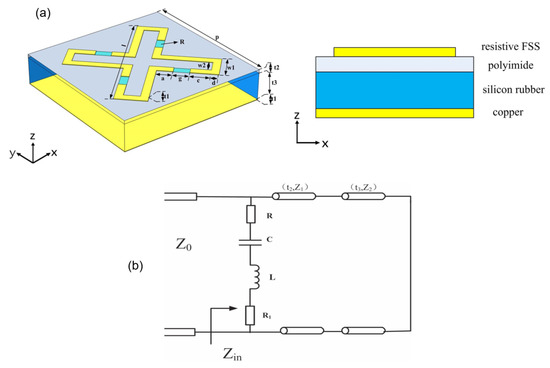
Figure 2.
Unit cell of the metamaterial absorber from different views: (a) perspective and front view and (b) an equivalent circuit model of the metamaterial absorber [45].
2.3. Controling the Absorption Bandwidth
The tunability of metamaterial absorbers refers to their remarkable capability to adjust and tailor the absorption properties across a wide range of frequencies. This characteristic is achieved through the strategic incorporation of tunable elements within the structure of a metamaterial absorber. By integrating these tunable components, the absorber becomes responsive to external control, allowing for dynamic and real-time adjustments to optimize the performance. Tunable metamaterial absorbers have emerged as a highly promising and versatile solution for controlling and effectively manipulating electromagnetic waves across various frequency bands. Their capability to adapt and modify the absorption characteristics makes them valuable in a multitude of applications, particularly, in the fields of energy harvesting, telecommunication, and sensing [47,48,49,50,51,52].
The principles of tailoring the bandwidth of a metamaterial absorber include manipulating the structural design and material properties of the absorber to achieve the desired absorption characteristics within a specific frequency range. This is made by engineering the resonant properties of the structure, which comprises adjusting the geometry and material composition of the metamaterial unit cell. By enabling the shift of resonant frequency, the tunable structure provides the remarkable capability of achieving absorption at various specific frequencies. This feature allows us to control precisely the absorption bandwidth of the metamaterial absorber. With this capability to adjust the resonant frequency, the absorber can be fine-tuned to target and absorb electromagnetic energy at the desired frequencies.
The development of tunable metamaterial absorbers needs the consideration of desired frequency range, tuning mechanism, and overall performance specifications. The successful realization of these absorbers has required the integration of various tuning mechanisms, such as optical [47] (Figure 3a), temperature [48] (Figure 3b), magnetical [49] (Figure 3c), electrical [50] (Figure 3d), and mechanical tuning mechanisms [51] (Figure 3e), in the metamaterial structure to achieve the desired level of tunability, as shown in Figure 3. The selection of a suitable tuning mechanism depends on several factors, such as the desired frequency range, required level of tunability, and practical constraints associated with the specific application. For instance, the optical tuning mechanism might be preferred for applications that require high-speed modulation and low-power consumption [47]. On the other hand, temperature and electrical tunings are more appropriate for applications which need precise and stable tuning over an extended period [48,50]. Similarly, the magnetical and mechanical tuning mechanisms also have their own special application purposes [49,51]. The integration of different tuning mechanisms within the metamaterial structure should be accompanied by the careful consideration of the design and fabrication process. This includes the selection of appropriate materials, the optimization of structural parameters, and the implementation of suitable fabrication techniques. The successful implementation of these processes is crucial to achieve the desired level of tunability and overall performance of the metamaterial absorber.
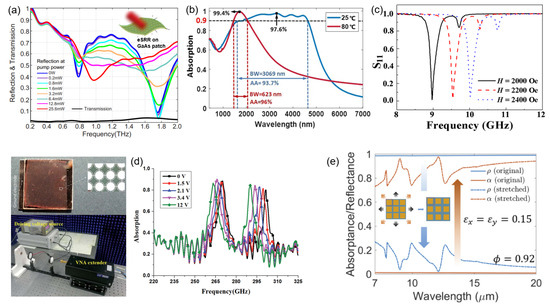
Figure 3.
Controlling the absorption band of a metamaterial absorber by using (a) optical [47], (b) temperature [48], (c) magnetic [49], (d) electrical [50], and (e) mechanical tuning schemes [51]. Blue and red arrows indicate the spectra after stretching.
3. Design Strategies for the Bandwidth of Metamaterial Absorbers
Based on the principles for a metamaterial absorber, as presented in the section above, the metamaterial can be designed to exhibit a high absorption at specific frequencies. In Figure 4a, a simple metamaterial structure featuring a snake-shaped design is depicted [30]. This structure allows us to control the absorption peaks in two frequency ranges of 2 GHz and 400 MHz. The manipulation of absorption frequencies was achieved by modifying the length of snake bar in the unit cell. The absorption characteristics of the structure were evaluated by using the wave scattering properties, as expressed by A(ω) = 1 − R(ω) − T(ω). Here, R(ω) represents the reflection coefficient (|S11|2), and T(ω) the transmission coefficient (|S21|2). To achieve perfect absorption [A(ω) = 1], it was necessary to ensure perfect impedance matching with the free space, denoted as []. This condition could be satisfied by optimizing the parameters of the unit cell. In the context of a perfect-absorber system, only the scattering parameter of reflection was considered, and the calculation of electromagnetic-wave absorption was performed solely based on A(ω) = 1 − |S11(ω)|2.
The development of metamaterial structures with the ability to resonate at multiple frequencies has led to the emergence of multiple-peak metamaterial absorbers. These innovative designs had the potential to exhibit dual, triple, or even quad peaks within a single structure. By carefully engineering the properties of these metamaterials, it becomes possible to manipulate their resonant behavior and achieve absorption at multiple distinct frequencies simultaneously. This advancement opens up new possibilities for the design and optimization of metamaterial absorbers with enhanced functionality and performance. Figure 4b illustrates a multiple-band metamaterial absorber operating in the microwave frequency range [53]. The absorber was composed of carefully arranged donut-shaped resonators of varying sizes, positioned alongside a metallic background plane and separated by a dielectric material. The absorber exhibits near-perfect absorption characteristics, with the presence of four distinct absorption peaks from 6 to 12 GHz.
The key advantage of broadband metamaterial absorbers is their ability to absorb electromagnetic waves over a broad frequency range, making them useful in various applications such as stealth technology or energy harvesting [54,55,56]. Unlike traditional absorbers that are limited to specific frequencies, the broadband absorbers can absorb a wide range of frequencies simultaneously. The design includes tailoring the structure and composition of metamaterials to achieve the desired absorption characteristics. This is obtained by manipulating the arrangement and geometry of constituent elements in the metamaterial, which can be metallic or dielectric components. By carefully engineering the properties of the metamaterial, the broadband absorbers secure a high absorption across a broad frequency range.
The superposition of resonance peaks is a widely employed technique in achieving the broadband absorption with metamaterials. This method combines multiple resonance modes or peaks that are different but similar in order to achieve the broadband-absorption characteristics. The superposition of these resonance peaks results in a broader and flatter absorption spectrum, which is a desirable feature in many applications. The metamaterial absorbers, based on this mechanism, have been often designed by using multilayer structures. These structures consist of alternating layers of metamaterial and dielectric material, which are designed carefully to achieve the desired broadband absorption. The thickness and composition of each layer are optimized to ensure the maximum absorption across a wide range of frequencies. Figure 4c illustrates a hybrid metamaterial absorber consisting of a conventional magnetic absorbing material and a multilayered meta-structure incorporating graphene films [57]. This multilayer metamaterial structure exhibits a wideband absorption capability in two distinct frequency bands, specifically, ranging from 0.79 to 20.9 GHz and from 25.1 to 40.0 GHz. The remarkable absorption performance of this structure can be attributed to the presence and effective coupling of fundamental resonance modes in the system.
Another approach that is increasingly utilized in the design of metamaterial absorbers is to reduce the quality factor of resonators. This can be accomplished by incorporating absorbent elements into the metamaterial structure, such as additional electric components like resistors or layers of highly-absorbent materials [58]. By reducing the quality factor, the resonators become less selective and are able to absorb a wider range of frequencies. This approach has been shown to be effective in achieving the broadband absorption in metamaterials. In addition to the aforementioned methods, other techniques, such as utilization of the spoof-plasmonic and slow-light waveguide effects, can also be employed to provide broadband absorption in metamaterials [59]. These approaches comprise manipulating the wave-propagation properties of metamaterial structures, which results in enhanced absorption characteristics. Liu et al. introduced the broadband metamaterial absorber featuring the center-spin unit cell, as depicted in Figure 4d [60]. The top layer of absorber consists of metallic components arranged in a single figure rotating around the center, interconnected by four identical 200-Ohm resistors. Through the reduction of the Q-factor of the meta-structure and careful adjustment to achieve impedance matching, the absorber demonstrated a remarkable absorption up to 90% across a frequency range of 2.2 to 5.2 GHz.
In addition to the aforementioned design methods for metamaterial absorbers, the metal that constructs the structure also influences the properties. Gold and silver support a broad range of operating wavelengths from visible to infrared, and copper is cost-effective and popular in the microwave and radio-frequency range [27,61]. Besides, aluminum, titanium and niobium are also used in fabricating metamaterial absorbers [62,63].
Beyond the traditional structures, the design space for broadband metamaterial absorbers is extended to encompass refractory materials, which are defined by their exceptional thermal resistance, melting points exceeding 2000 °C, and remarkable chemical stability under extreme temperature conditions. Refractory metamaterial absorbers are specifically engineered for efficient broadband absorption, even at elevated temperatures. Notably, they can achieve near-perfect absorption (>90%), minimizing undesirable reflections and heat generation. This exceptional capability stems from the incorporation of refractory materials like silicon carbide and titanium nitride, endowing them with the resilience to operate under harsh thermal conditions, exceeding 2000 °C. Consequently, refractory metamaterial absorbers unlock access to previously inaccessible applications, including solar energy, industrial furnaces, space shuttle shields, and even semiconductor technology [62,63,64,65,66].
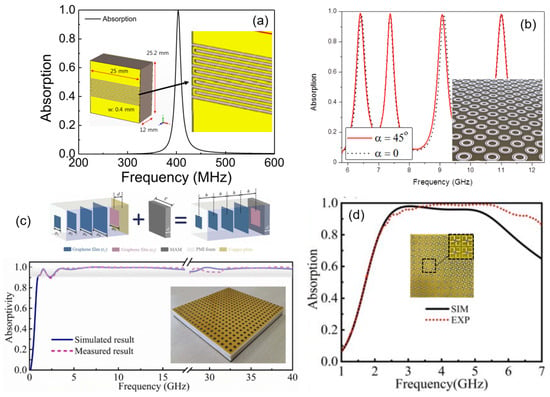
Figure 4.
(a) Single-peak metamaterial absorber [30], (b) multiple-peak metamaterial absorber [53], (c) broadband metamaterial absorber with a multilayer structure [57], and (d) broadband metamaterial absorber with resistor [60].
4. Broadband Metamaterial Absorber Properties: Polarization Insensitivity and Wide Incident Angle
4.1. Polarization Insensitivity
Polarization-insensitive metamaterials have been developed to overcome the limitations of conventional metamaterials, which are sensitive to the polarization of incident electromagnetic waves. These metamaterials are designed to exhibit identical absorption properties for both the transverse-electric (TE) and transverse-magnetic (TM) modes of electromagnetic waves. Polarization-insensitive metamaterial absorbers have the capability to absorb electromagnetic waves across a wide range of frequencies, regardless of their polarization state. The insensitive polarization properties can be achieved by careful design considerations and fabrication techniques, such as structural symmetry, multi-resonant elements, etc. [67]. These metamaterials have numerous potential applications, including sensing, imaging, and communication systems, where they can provide enhanced performance and improved reliability, compared to conventional ones.
A polarization-insensitive metamaterial absorber with high absorption performance was proposed by Zheng et al. [68]. The structure consists of five layers arranged in the following order: the top layer is a copper pattern layer, followed by an upper polyimide layer, a resistive sheet, a lower polyimide layer, and finally, a continuous copper layer at the bottom. This configuration is illustrated in Figure 5a. The copper used in the structure had a conductivity of 5.8 × 108 S/m, while the resistive sheet had a resistance of 540 Ω/sq. The polyimide layers had a dielectric constant of 3.5 and a loss tangent of 0.0027. The periodicity of the structure was 4.4 mm. To investigate the metamaterial structure, the periodic boundary conditions were applied on the x-y plane, as depicted in Figure 5b. Figure 5c displays the outcomes of the study, demonstrating the near-perfect absorption (99.8%) of the metamaterial structure across a wavelength range from 26.35 to 31.9 GHz for both TE and TM-polarized waves at the normal incidence. Furthermore, due to their inherent symmetry, the metamaterial structures exhibited an insensitivity to polarization angle, as illustrated in Figure 5d.
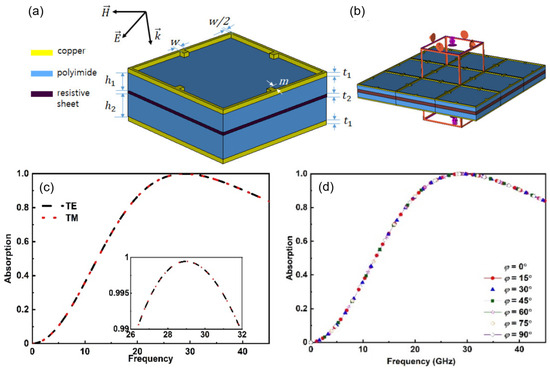
Figure 5.
(a) Schematic of the symmetric unit cell, (b) boundary conditions for the simulation, (c) absorption spectra for the TE and TM polarization, and (d) absorption spectra at various polarization angles [68].
4.2. Wide Incident Angle
Wide incident-angle metamaterial absorbers have been developed to address the challenge of achieving a high absorption over a wide range of incident angles. These absorbers are composed of a metamaterial structure that is designed to exhibit the desired electromagnetic properties, such as effective permittivity and permeability, over a broad range of incident angles. By carefully engineering the unit-cell geometry and material composition, the absorber can achieve a high absorption even when the incident angle of electromagnetic waves deviates significantly from the normal direction. The wide incident-angle metamaterial absorbers have several advantages over the conventional absorbers, including their ability to maintain a high absorption over a broad range of incident angles, which makes them suitable for various applications where the incident waves arrive from different directions. Several approaches have been proposed to design them, including symmetrical and multi-layered structures [69,70]. The development of wide incident-angle metamaterial absorbers has significant implications for various applications, such as radar and communication systems where the incident waves come from different directions and angles [71,72]. However, further research is needed to optimize the design and performance of these absorbers for specific applications and to overcome the challenges associated with their implementation.
The unit-cell design of this kind of broadband metamaterial absorber is depicted in Figure 6a–c from different perspectives: perspective, side, and top views. The unit cell was in a circular shape with slots and equipped with resistors [73]. Kalraiya et al. [73] achieved a broad range of higher than 90% of absorption between 5 and 10.5 GHz by adjusting the resistor values, as illustrated in Figure 6d. Additionally, the high symmetry of the circular unit cell rendered the metamaterial absorber to have a wide range of incident angles, as demonstrated in Figure 6e. The broadband of the metamaterial absorber can be maintained to be above 90% at an incident angle up to 30 degrees, and to be above 80% even at an incident angle of 45 degrees or higher.
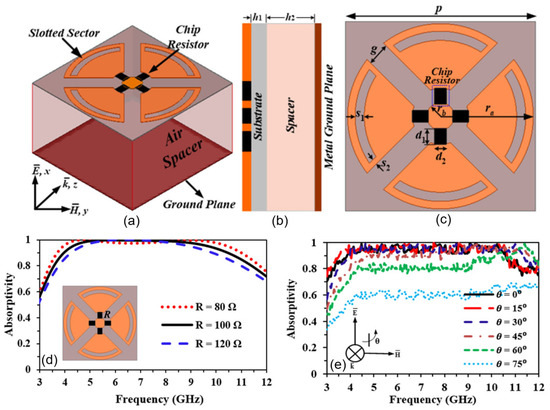
Figure 6.
(a) Unit-cell geometry of the metamaterial absorber, (b) side and (c) top view. (d) Absorption spectrum according to the resistor value. (e) Absorption spectrum at various polarizations [73].
5. Applications
Metamaterial absorbers have found numerous applications across various fields, due to their unique electromagnetic properties and absorption capabilities. The applications also vary, depending on the single-peak, multi-peak, or broadband absorption characteristics. Narrowband absorbers can be applied for sensing and detection by using the sensitive characteristic of resonance peaks with the surrounding environment, while broadband absorption is more powerful for various applications. Some of their notable applications are as follows.
Antenna Design: Broadband metamaterial absorbers are utilized in antenna design to enhance performance. They can be used to suppress unwanted reflections, reduce the side lobes, and improve the overall efficiency and bandwidth [74]. By incorporating the metamaterial absorbers, researchers could achieve improved antenna characteristics and optimize the antenna performance for specific applications. Figure 7a shows a proposed metamaterial antenna structure in the simulation layout and photo of the prototype [75]. The antenna employed a configuration of ten metamaterial unit cells, each of which consisted of a pair of series interdigital capacitors and a short-circuited inductive stub by using a metallic interconnection. A lossy substrate FR-4 with a thickness of 0.8 mm, loss-tangent of 0.025 was used to implement a prototype of the proposed planar antenna. The effect of a metamaterial antenna with a substrate-integrated waveguide (SIWs) is demonstrated in Figure 7b by the simulated and measured reflection coefficient (S11) and transmission one (S21). S11 quantifies the impedance matching, and S21 presents the isolation between the two ports. The results illustrate that the reflection and transmission coefficients in the cases with SIWs are much better than those without SIWs. This demonstrates that the reflection and transmission coefficients are significantly improved by employing the SIWs.
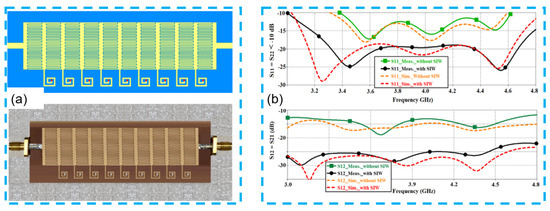
Figure 7.
(a) Simulation layout and photo of the fabricated prototype. (b) Simulated and measured S-parameters of the metamaterial-inspired antenna before and after applying the SIWs [75].
Radar Cross-section Reduction: Broadband metamaterial absorbers play a crucial role in stealth technology by reducing the radar cross-section (RCS) of objects or structures. By absorbing and selectively dissipating incident electromagnetic waves, the metamaterial absorbers can effectively minimize the radar signature of objects, making them less detectable by radar systems [76]. This application has significant implications for military and defense research. A coding metasurface is a cutting-edge technology which manipulates electromagnetic waves, based on the cleverly-designed properties of the unit cell called meta-atoms. These meta-atoms were engineered to control the phase, amplitude, and polarization of reflected waves. A broadband coding metamaterial was designed for the RCS reduction, as presented in Figure 8a [77]. The RCS was manipulated by the different metamaterial coding sequences, as shown in Figure 8b.

Figure 8.
(a) Fabricated coding metasurface and (b) transmission coefficient [77].
Sensing and Detection: Broadband metamaterial absorbers have been explored for sensing and detection applications by using the tailored absorption-frequency characteristic. They can be designed to selectively absorb specific frequencies, enabling us to have enhanced sensitivity and accuracy in various types of sensors. This includes applications in areas such as gas sensing, malaria, glucose, and environmental monitoring [61,78]. In [79], a metamaterial sensor based on a rectangle enclosing adjacent triple split-ring resonators (SRRs) is presented to recognize various oils, fluids and chemicals within the X band. Figure 9 shows the experimental setup for measuring the liquid using the metamaterial sensor, and includes the following details: front view of the fabricated metamaterial-based sensor (Figure 9a), back view (Figure 9b), liquid insertion process (Figure 9c), experimental setup of the waveguide (Figure 9d), sensor attached with the X-band waveguide (Figure 9e), and sample holder attached with an extended guided wave (Figure 9f). S11 results for palm and sunflower oil are in Figure 9g, and for benzene and carbon tetrachloride are in Figure 9h. Depending on the liquid, the resonance frequency of the metamaterial sensor was shifted in both simulation and measurement. Based on this characteristic, the liquid could be detected and classified. In other work, the tunable metamaterial absorber was also applied for the sensing application. Zhang et al. described how the absorption resonances of split-disk metamaterials could be tailored to cover a wide wavelength range of 1.5 to 5.0 µm by adjusting the geometrical configurations [80]. The sensor devices, based on these configurations, exhibited high sensitivities of 3312, 3342, 3362, and 3567 nm/RIU, respectively. This finding suggests a promising avenue for the development of optical-gas sensors and biosensors with a high sensitivity.
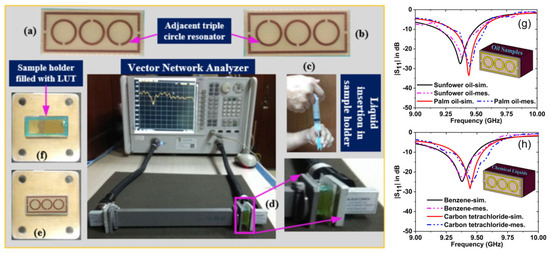
Figure 9.
(a) Front view of the fabricated metamaterial-based sensor, (b) back view, (c) liquid insertion process, (d) experimental setup of waveguide, (e) sensor attached with the X-band waveguide, and (f) sample holder attached with an extended guided wave. (g) S11 results for palm and sunflower oil, and (h) benzene and carbon tetrachloride [79].
Energy Harvesting: Broadband metamaterial absorbers have shown promise in energy harvesting applications. By efficiently absorbing incident electromagnetic waves across a broad frequency range, they can convert this absorbed energy into usable electrical power. This application has potential in areas such as wireless power transfer, self-powered sensors, and energy harvesting from the ambient electromagnetic radiation [18,81]. Fowler et al. presented a radio-frequency (RF) energy harvesting device that exhibited a high efficiency [82]. The device utilized a metamaterial perfect absorber integrated with Schottky diodes to achieve the efficient conversion of captured RF waves into DC power. The experimental results revealed that the rectenna was capable of generating a power output of 100 µW when subjected to an incident intensity of 0.4 µW/cm2. The design of unit cell of the rectenna-based metamaterial was constructed from an SRR array with Schottky diodes embedded in the gaps. The metamaterial design and current analysis are presented in Figure 10. In other previous work, a tunable perfect metamaterial absorber was introduced for electromagnetic-energy harvesting [83]. The absorber consisted of a circular ring with a groove and varactor diodes, providing flexibility and reconfigurability. The proposed tunable structure, despite its simple geometry, achieved a near-perfect absorption of 99.91% and 84.79% at frequencies of 5.01 and 4.79 GHz, respectively. The objective of this study was to demonstrate the collection of electromagnetic energy without polarization concerns by employing the tunable dual-band metamaterial absorber. This kind of absorber can serve as a guide for designing new absorbers at higher frequencies and be applied in various electromagnetic-energy harvesting applications, including power transfer and wireless power transmission.
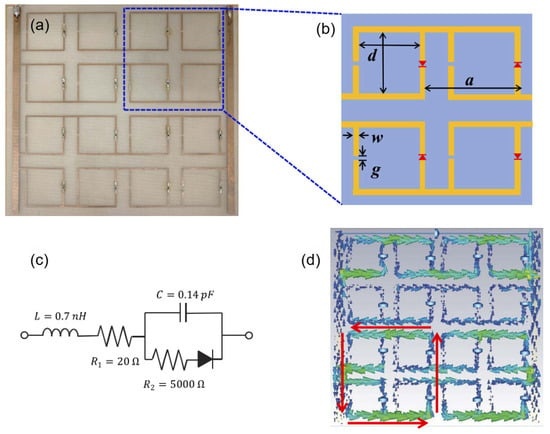
Figure 10.
Design of a rectenna-based metamaterial. (a) SRR array with diodes embedded in the gaps, (b) sketch model of the unit cell, (c) equivalent circuit model of the Schottky diode, and (d) surface-current distribution at the resonance frequency [81].
Imaging: Broadband metamaterial absorbers have been investigated for imaging applications. By tailoring the absorption properties of the absorber, researchers can obtain improved contrast and resolution in imaging techniques such as MRI (magnetic resonance imaging), terahertz imaging, and microscopy [84]. The metamaterial absorbers also find applications in optical devices, such as filters and modulators. In [85], a metamaterial structure used to enhance the performance of THz reflectance imaging was investigated. This THz reflectance imaging with metamaterial was used to resolve different regions of mouse brain tissue due to the difference in their refractive index. Figure 10a illustrates the schematic of the THz-reflection measurement process. The metamaterial with polydimethylsiloxane sample was mounted onto a two-dimensional moving stage for a raster scan, and the reflectance images of 60 × 60 pixels with a resolution of 250 µm were obtained by using a THz time-domain spectroscopy system. Figure 11b presents a reflectance image at an incident angle of 65 degrees. This image at a resonance frequency of 1.1 THz exhibited the highest contrast and sensitivity.
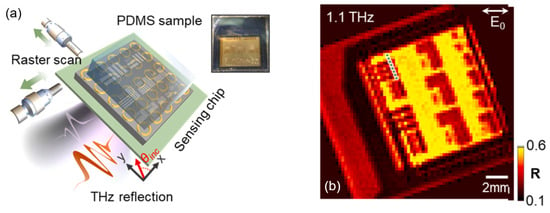
Figure 11.
(a) Experimental process for THz-reflection measurement with a motorized raster-scanning stage, and (b) reflectance images at 1.1 THz by using the metamaterial [85].
These are just a few examples of the diverse applications of broadband metamaterial absorbers. The ongoing research and developments in this field continue to expand the potential of metamaterial absorbers in various scientific disciplines.
6. Conclusions and Future Perspectives
This review provides an overview on broadband metamaterials, covering their operating principles, design considerations, properties, and applications. Metamaterials can be engineered to exhibit absorption at single- or multiple-peak frequencies, as well as tailored- and broad-band absorption. Among different classes of metamaterials, broadband metamaterials demonstrate the highest level of versatility and find widespread applications. Efforts are being made to enhance the practical applicability of metamaterials by investigating the structures that possess polarization insensitivity and cover a wide incident-angle range. These unique characteristics enable broadband metamaterials to be employed in various fields, including antenna performance enhancement, radar cross-section reduction, sensing, energy harvesting, and imaging. In conclusion, broadband metamaterials have emerged as a promising area of research with a wide range of applications. The unique properties of these structures let us precisely control electromagnetic waves, leading to unprecedented opportunities for the design of novel devices and systems. By looking ahead, the continued research and development in the field of broadband metamaterials is expected to unlock new possibilities and drive innovation in various industries. The future of metamaterials holds great promise for advancements in optics, wireless communications, energy harvesting, sensing and imaging, acoustics, and flexible electronics.
Author Contributions
Conceptualization, Y.L. and H.Z.; methodology, T.S.P.; validation, L.C. and Y.L.; investigation, H.Z.; writing—original draft preparation, T.S.P.; writing—review and editing, Y.L.; supervision, Y.L. All of the authors discussed and commented on the manuscript. All authors have read and agreed to the published version of the manuscript.
Funding
This research is funded by the Korea Evaluation Institute of Industrial Technology (Project No. 20016179).
Data Availability Statement
The data presented in this study are available on request from the corresponding author. The data are not publicly available due to privacy concerns.
Acknowledgments
We appreciate the Korea Evaluation Institute of Industrial Technology.
Conflicts of Interest
The authors declare no conflicts of interest.
References
- Wang, B.-X.; Xu, C.; Duan, G.; Xu, W.; Pi, F. Review of Broadband Metamaterial Absorbers: From Principles, Design Strategies, and Tunable Properties to Functional Applications. Adv. Funct. Mater. 2023, 33, 2213818. [Google Scholar] [CrossRef]
- Rhee, J.Y.; Kim, Y.J.; Yi, C.; Hwang, J.S.; Lee, Y.P. Recent Progress in Perfect Absorbers by Utilizing Metamaterials. J. Electromagn. Waves Appl. 2020, 34, 1338–1371. [Google Scholar] [CrossRef]
- Mei, H.; Yang, W.; Yang, D.; Yao, L.; Yao, Y.; Chen, C.; Cheng, L. Metamaterial Absorbers towards Broadband, Polarization Insensitivity and Tunability. Opt. Laser Technol. 2022, 147, 107627. [Google Scholar] [CrossRef]
- Gómez-Castaño, M.; Garcia-Pomar, J.L.; Pérez, L.A.; Shanmugathasan, S.; Ravaine, S.; Mihi, A. Electrodeposited Negative Index Metamaterials with Visible and near Infrared Response. Adv. Opt. Mater. 2020, 8, 2000865. [Google Scholar] [CrossRef]
- Zhai, S.L.; Zhao, X.P.; Liu, S.; Shen, F.L.; Li, L.L.; Luo, C.R. Inverse Doppler Effects in Broadband Acoustic Metamaterials. Sci. Rep. 2016, 6, 32388. [Google Scholar] [CrossRef]
- Cai, W.; Chettiar, U.K.; Kildishev, A.V.; Shalaev, V.M. Optical Cloaking with Metamaterials. Nat. Photonics 2007, 1, 224–227. [Google Scholar] [CrossRef]
- Chen, Z.; Ma, X.; Duan, Y.; Li, L.; Zhang, S.; Wang, Y.; Yu, Y.; Hou, Z. Tunable Electromagnetically Induced Absorption Based on Coupled-Resonators in a Compact Plasmonic System. Opt. Express 2023, 31, 35697–35708. [Google Scholar] [CrossRef]
- Ranaweera, A.L.A.K.; Pham, T.S.; Bui, H.N.; Ngo, V.; Lee, J.-W. An Active Metasurface for Field-Localizing Wireless Power Transfer Using Dynamically Reconfigurable Cavities. Sci. Rep. 2019, 9, 11735. [Google Scholar] [CrossRef]
- Hiep, L.T.H.; Pham, T.S.; Khuyen, B.X.; Tung, B.S.; Ngo, Q.M.; Hien, N.T.; Minh, N.T.; Lam, V.D. Enhanced Transmission Efficiency of Magneto-Inductive Wave Propagating in Non-Homogeneous 2-D Magnetic Metamaterial Array. Phys. Scr. 2022, 97, 025504. [Google Scholar] [CrossRef]
- Cerjan, B.; Gerislioglu, B.; Link, S.; Nordlander, P.; Halas, N.J.; Griep, M.H. Towards Scalable Plasmonic Fano-Resonant Metasurfaces for Colorimetric Sensing. Nanotechnology 2022, 33, 405201. [Google Scholar] [CrossRef]
- Xue, Y.-Y.; Li, J.-S. Terahertz All-Dielectric Metasurface Sensor Based on Quasi-Bound States in the Continuum. Appl. Opt. 2023, 62, 1610–1615. [Google Scholar] [CrossRef] [PubMed]
- Yu, P.; Besteiro, L.V.; Huang, Y.; Wu, J.; Fu, L.; Tan, H.H.; Jagadish, C.; Wiederrecht, G.P.; Govorov, A.O.; Wang, Z. Broadband Metamaterial Absorbers. Adv. Opt. Mater. 2019, 7, 1800995. [Google Scholar] [CrossRef]
- Yoo, Y.J.; Hwang, J.S.; Lee, Y.P. Flexible Perfect Metamaterial Absorbers for Electromagnetic Wave. J. Electromagn. Waves Appl. 2017, 31, 663–715. [Google Scholar] [CrossRef]
- Son, P.T.; Khuyen, B.X.; Tung, B.S.; Hiep, L.T.H.; Lam, V.D. A Critical Review on Wireless Power Transfer Systems Using Metamaterials. Vietnam J. Sci. Technol. 2022, 60, 587–613. [Google Scholar] [CrossRef]
- Zhou, Y.; Qin, Z.; Liang, Z.; Meng, D.; Xu, H.; Smith, D.R.; Liu, Y. Ultra-Broadband Metamaterial Absorbers from Long to Very Long Infrared Regime. Light Sci. Appl. 2021, 10, 138. [Google Scholar] [CrossRef]
- Landy, N.I.; Sajuyigbe, S.; Mock, J.J.; Smith, D.R.; Padilla, W.J. Perfect Metamaterial Absorber. Phys. Rev. Lett. 2008, 100, 207402. [Google Scholar] [CrossRef]
- Lang, T.; Xiao, M.; Cen, W. Graphene-Based Metamaterial Sensor for Pesticide Trace Detection. Biosensors 2023, 13, 560. [Google Scholar] [CrossRef]
- Lee, G.; Lee, D.; Park, J.; Jang, Y.; Kim, M.; Rho, J. Piezoelectric Energy Harvesting Using Mechanical Metamaterials and Phononic Crystals. Commun. Phys. 2022, 5, 94. [Google Scholar] [CrossRef]
- Jiang, S.; Li, J.; Li, J.; Lai, J.; Yi, F. Metamaterial Microbolometers for Multi-Spectral Infrared Polarization Imaging. Opt. Express 2022, 30, 9065–9087. [Google Scholar] [CrossRef]
- Chen, C.; Huang, Y.; Wu, K.; Bifano, T.G.; Anderson, S.W.; Zhao, X.; Zhang, X. Polarization Insensitive, Metamaterial Absorber-Enhanced Long-Wave Infrared Detector. Opt. Express 2020, 28, 28843–28857. [Google Scholar] [CrossRef]
- Ha, D.T.; Tung, B.S.; Khuyen, B.X.; Pham, T.S.; Tung, N.T.; Tung, N.H.; Hoa, N.T.; Lam, V.D.; Zheng, H.; Chen, L.; et al. Dual-Band, Polarization-Insensitive, Ultrathin and Flexible Metamaterial Absorber Based on High-Order Magnetic Resonance. Photonics 2021, 8, 574. [Google Scholar] [CrossRef]
- Long, L.V.; Khiem, N.S.; Tung, B.S.; Tung, N.T.; Giang, T.T.; Son, P.T.; Khuyen, B.X.; Lam, V.D.; Chen, L.; Zheng, H.; et al. Flexible Broadband Metamaterial Perfect Absorber Based on Graphene-Conductive Inks. Photonics 2021, 8, 440. [Google Scholar] [CrossRef]
- Van Long, L.; Dung, D.N.; Son, P.T.; Tung, N.T.; Hanh, V.T.H.; Ha, D.T.; Chi, D.T.; Tung, B.S.; Khuyen, B.X.; Lam, V.D. Robust Reversion of Dual-Band Polarization Conversion and Absorption Based on Flexible Metamaterial. J. Phys. Soc. Jpn. 2023, 92, 024801. [Google Scholar] [CrossRef]
- Long, L.V.; Tung, N.H.; Giang, T.T.; Son, P.T.; Tung, N.T.; Tung, B.S.; Khuyen, B.X.; Lam, V.D. Rotary Bi-Layer Ring-Shaped Metamaterials for Reconfiguration Absorbers. Appl. Opt. 2022, 61, 9078–9084. [Google Scholar] [CrossRef] [PubMed]
- Guan, Z.; Liu, Y.; Li, Y.; Zhao, P.; Zhang, Y.; Jiang, S. Dual-Band Terahertz Perfect Absorber Based on Metal Micro-Nano Structure. Coatings 2022, 12, 687. [Google Scholar] [CrossRef]
- Feng, H.; Zhang, Z.; Zhang, J.; Fang, D.; Wang, J.; Liu, C.; Wu, T.; Wang, G.; Wang, L.; Ran, L.; et al. Tunable Dual-Broadband Terahertz Absorber with Vanadium Dioxide Metamaterial. Nanomaterials 2022, 12, 1731. [Google Scholar] [CrossRef] [PubMed]
- Alsulami, Q.A.; Wageh, S.; Al-Ghamdi, A.A.; Bilal, R.M.H.; Saeed, M.A. A Tunable and Wearable Dual-Band Metamaterial Absorber Based on Polyethylene Terephthalate (PET) Substrate for Sensing Applications. Polymers 2022, 14, 4503. [Google Scholar] [CrossRef]
- Ha, D.T.; Dzung, D.N.; Ngoc, N.V.; Tung, B.S.; Pham, T.S.; Lee, Y.; Chen, L.Y.; Khuyen, B.X.; Lam, V.D. Switching between Perfect Absorption and Polarization Conversion, Based on Hybrid Metamaterial in the GHz and THz Bands. J. Phys. Appl. Phys. 2021, 54, 234003. [Google Scholar] [CrossRef]
- Yoo, Y.J.; Kim, Y.J.; Lee, Y. Perfect Absorbers for Electromagnetic Wave, Based on Metamaterials. J. Korean Phys. Soc. 2015, 67, 1095–1109. [Google Scholar] [CrossRef]
- Yoo, Y.J.; Zheng, H.Y.; Kim, Y.J.; Rhee, J.Y.; Kang, J.-H.; Kim, K.W.; Cheong, H.; Kim, Y.H.; Lee, Y.P. Flexible and Elastic Metamaterial Absorber for Low Frequency, Based on Small-Size Unit Cell. Appl. Phys. Lett. 2014, 105, 041902. [Google Scholar] [CrossRef]
- Luu, D.H.; Van Dung, N.; Hai, P.; Giang, T.T.; Lam, V.D. Switchable and Tunable Metamaterial Absorber in THz Frequencies. J. Sci. Adv. Mater. Devices 2016, 1, 65–68. [Google Scholar] [CrossRef][Green Version]
- Khuyen, B.X.; Tung, B.S.; Kim, Y.J.; Hwang, J.S.; Kim, K.W.; Rhee, J.Y.; Lam, V.D.; Kim, Y.H.; Lee, Y. Ultra-Subwavelength Thickness for Dual/Triple-Band Metamaterial Absorber at Very Low Frequency. Sci. Rep. 2018, 8, 11632. [Google Scholar] [CrossRef]
- Kim, Y.J.; Kim, J.M.; Yoo, Y.J.; Tuong, P.V.; Zheng, H.; Rhee, J.Y.; Lee, Y. Dual-Absorption Metamaterial Controlled by Electromagnetic Polarization. J. Opt. Soc. Am. B 2014, 31, 2744–2747. [Google Scholar] [CrossRef]
- Nam, M.H.; Tung, B.S.; Khuyen, B.X.; Ha, D.T.; Ngoc, N.V.; Tran, M.C.; Le, D.T.; Lam, V.D.; Chen, L.; Zheng, H.; et al. Graphene-Integrated Plasmonic Metamaterial for Manipulation of Multi-Band Absorption, Based on near-Field Coupled Resonators. Crystals 2022, 12, 525. [Google Scholar] [CrossRef]
- Liang, C.; Kong, X.; Wang, F.; Xu, R.; Fu, Y.; Pang, X.; Zhang, S.; Shen, X.; Zhao, L. A Broadband Perfect Metamaterial Absorber with Angle-Insensitive Characteristics. J. Electromagn. Waves Appl. 2023, 37, 401–410. [Google Scholar] [CrossRef]
- Qu, S.; Hou, Y.; Sheng, P. Conceptual-Based Design of an Ultrabroadband Microwave Metamaterial Absorber. Proc. Natl. Acad. Sci. USA 2021, 118, e2110490118. [Google Scholar] [CrossRef] [PubMed]
- Mattiucci, N.; Bloemer, M.J.; Aközbek, N.; D’Aguanno, G. Impedance Matched Thin Metamaterials Make Metals Absorbing. Sci. Rep. 2013, 3, 3203. [Google Scholar] [CrossRef]
- Jung, J.; Park, H.; Park, J.; Chang, T.; Shin, J. Broadband Metamaterials and Metasurfaces: A Review from the Perspectives of Materials and Devices. Nanophotonics 2020, 9, 3165–3196. [Google Scholar] [CrossRef]
- Liu, T.; Caballero, J.M.; Wang, Y. Design of Metamaterial Solar Absorber Based on Impedance Matching Theory. Plasmonics 2023, 1–11. [Google Scholar] [CrossRef]
- Kim, Y.J.; Yoo, Y.J.; Hwang, J.S.; Lee, Y.P. Ultrathin Microwave Absorber Based on Metamaterial. J. Phys. Appl. Phys. 2016, 49, 435102. [Google Scholar] [CrossRef]
- Sayed, S.I.; Mahmoud, K.R.; Mubarak, R.I. Design and Optimization of Broadband Metamaterial Absorber Based on Manganese for Visible Applications. Sci. Rep. 2023, 13, 11937. [Google Scholar] [CrossRef]
- Deng, G.; Lv, K.; Sun, H.; Hong, Y.; Zhang, X.; Yin, Z.; Li, Y.; Yang, J. An Ultra-Wideband, Polarization Insensitive Metamaterial Absorber Based on Multiple Resistive Film Layers with Wide-Incident-Angle Stability. Int. J. Microw. Wirel. Technol. 2020, 13, 58–66. [Google Scholar] [CrossRef]
- Norouzi, M.; Jarchi, S.; Ghaffari-Miab, M.; Esfandiari, M.; Lalbakhsh, A.; Koziel, S.; Reisenfeld, S.; Moloudian, G. 3D Metamaterial Ultra-Wideband Absorber for Curved Surface. Sci. Rep. 2023, 13, 1043. [Google Scholar] [CrossRef]
- Chen, H.-T. Interference Theory of Metamaterial Perfect Absorbers. Opt. Express 2012, 20, 7165–7172. [Google Scholar] [CrossRef]
- Chen, H.; Yang, X.; Wu, S.; Zhang, D.; Xiao, H.; Huang, K.; Zhu, Z.; Yuan, J. Flexible and Conformable Broadband Metamaterial Absorber with Wide-Angle and Polarization Stability for Radar Application. Mater. Res. Express 2018, 5, 015804. [Google Scholar] [CrossRef]
- Amer, A.A.G.; Sapuan, S.Z.; Alzahrani, A.; Nasimuddin, N.; Salem, A.A.; Ghoneim, S.S.M. Design and Analysis of Polarization-Independent, Wide-Angle, Broadband Metasurface Absorber Using Resistor-Loaded Split-Ring Resonators. Electronics 2022, 11, 1986. [Google Scholar] [CrossRef]
- Zhao, X.; Fan, K.; Zhang, J.; Seren, H.R.; Metcalfe, G.D.; Wraback, M.; Averitt, R.D.; Zhang, X. Optically Tunable Metamaterial Perfect Absorber on Highly Flexible Substrate. Sens. Actuators Phys. 2015, 231, 74–80. [Google Scholar] [CrossRef]
- Lei, L.; Lou, F.; Tao, K.; Huang, H.; Cheng, X.; Xu, P. Tunable and Scalable Broadband Metamaterial Absorber Involving VO2-Based Phase Transition. Photonics Res. 2019, 7, 734–741. [Google Scholar] [CrossRef]
- Lei, M.; Feng, N.; Wang, Q.; Hao, Y.; Huang, S.; Bi, K. Magnetically Tunable Metamaterial Perfect Absorber. J. Appl. Phys. 2016, 119, 244504. [Google Scholar] [CrossRef]
- Yin, Z.; Lu, Y.; Xia, T.; Lai, W.; Yang, J.; Lu, H.; Deng, G. Electrically Tunable Terahertz Dual-Band Metamaterial Absorber Based on a Liquid Crystal. RSC Adv. 2018, 8, 4197–4203. [Google Scholar] [CrossRef]
- Chen, F.; Liu, X.; Tian, Y.; Zheng, Y. Mechanically Stretchable Metamaterial with Tunable Mid-Infrared Optical Properties. Opt. Express 2021, 29, 37368–37375. [Google Scholar] [CrossRef]
- Guo, Y.; Hou, X.; Lv, X.; Bi, K.; Lei, M.; Zhou, J. Tunable Artificial Microwave Blackbodies Based on Metasurfaces. Opt. Express 2017, 25, 25879–25885. [Google Scholar] [CrossRef]
- Park, J.W.; Tuong, P.V.; Rhee, J.Y.; Kim, K.W.; Jang, W.H.; Choi, E.H.; Chen, L.Y.; Lee, Y. Multi-Band Metamaterial Absorber Based on the Arrangement of Donut-Type Resonators. Opt. Express 2013, 21, 9691–9702. [Google Scholar] [CrossRef]
- Ullah, N.; Islam, M.S.; Hoque, A.; Yong, W.H.; Alrashdi, A.M.; Soliman, M.S.; Islam, M.T. An Efficient, Compact, Wide-Angle, Wide-Band, and Polarization-Insensitive Metamaterial Electromagnetic Energy Harvester. Alex. Eng. J. 2023, 82, 377–388. [Google Scholar] [CrossRef]
- Quan, C.; Zou, J.; Guo, C.; Xu, W.; Zhu, Z.; Zhang, J. High-Temperature Resistant Broadband Infrared Stealth Metamaterial Absorber. Opt. Laser Technol. 2022, 156, 108579. [Google Scholar] [CrossRef]
- Zheng, H.; Chen, L.; Lee, Y. High-Performance and Flexible Metamaterial Wave Absorbers with Specific Bandwidths for the Microwave Device. Crystals 2023, 13, 868. [Google Scholar] [CrossRef]
- Zhang, C.; Yin, S.; Long, C.; Dong, B.W.; He, D.; Cheng, Q. Hybrid Metamaterial Absorber for Ultra-Low and Dual-Broadband Absorption. Opt. Express 2021, 29, 14078–14086. [Google Scholar] [CrossRef]
- Li, S.; Gao, J.; Cao, X.; Li, W.; Zhang, Z.; Zhang, D. Wideband, Thin, and Polarization-Insensitive Perfect Absorber Based the Double Octagonal Rings Metamaterials and Lumped Resistances. J. Appl. Phys. 2014, 116, 043710. [Google Scholar] [CrossRef]
- Bai, J.; Yang, Q.; Liang, Y.; Gao, X. Broadband Frequency Selective Rasorber Based on Spoof Surface Plasmon Polaritons. Micromachines 2022, 13, 1969. [Google Scholar] [CrossRef]
- Liu, S.; Ding, F.; Wu, J.; Zhang, Q.; Yang, H. A Metamaterial Absorber with Centre-Spin Design and Characteristic Modes Analysis. Phys. Scr. 2022, 97, 045502. [Google Scholar] [CrossRef]
- Karthikeyan, M.; Jayabala, P.; Ramachandran, S.; Dhanabalan, S.S.; Sivanesan, T.; Ponnusamy, M. Tunable Optimal Dual Band Metamaterial Absorber for High Sensitivity THz Refractive Index Sensing. Nanomaterials 2022, 12, 2693. [Google Scholar] [CrossRef]
- Liu, Z.; Liu, G.; Huang, Z.; Liu, X.; Fu, G. Ultra-Broadband Perfect Solar Absorber by an Ultra-Thin Refractory Titanium Nitride Meta-Surface. Sol. Energy Mater. Sol. Cells 2018, 179, 346–352. [Google Scholar] [CrossRef]
- Guler, U.; Boltasseva, A.; Shalaev, V.M. Refractory Plasmonics. Science 2014, 344, 263–264. [Google Scholar] [CrossRef]
- Liu, Z.; Liu, G.; Liu, X.; Chen, J.; Tang, C. Spatial and Frequency-Selective Optical Field Coupling Absorption in an Ultra-Thin Random Metasurface. Opt. Lett. 2023, 48, 1586–1589. [Google Scholar] [CrossRef]
- Zhou, J.; Liu, Z.; Liu, G.; Pan, P.; Liu, X.; Tang, C.; Liu, Z.; Wang, J. Ultra-Broadband Solar Absorbers for High-Efficiency Thermophotovoltaics. Opt. Express 2020, 28, 36476–36486. [Google Scholar] [CrossRef]
- Weng, Z.; Guo, Y. Broadband Perfect Optical Absorption by Coupled Semiconductor Resonator-Based All-Dielectric Metasurface. Materials 2019, 12, 1221. [Google Scholar] [CrossRef]
- Guo, Y.; Li, J.; Hou, X.; Lv, X.; Liang, H.; Zhou, J. A Simple Topology Metamaterial Blackbody for Visible Light. J. Alloys Compd. 2017, 699, 998–1002. [Google Scholar] [CrossRef]
- Zheng, H.; Chen, L.; Lee, Y.-P. Flexible Metamaterial Absorber with Tailored Bandwidth and High Absorption Performance. Crystals 2022, 12, 182. [Google Scholar] [CrossRef]
- Nguyen, T.T.; Lim, S. Wide Incidence Angle-Insensitive Metamaterial Absorber for Both TE and TM Polarization Using Eight-Circular-Sector. Sci. Rep. 2017, 7, 3204. [Google Scholar] [CrossRef]
- Hakim, M.L.; Alam, T.; Islam, M.S.; Salaheldeen, M.M.; Almalki, S.H.A.; Baharuddin, M.H.; Alsaif, H.; Islam, M.T. Wide-Oblique-Incident-Angle Stable Polarization-Insensitive Ultra-Wideband Metamaterial Perfect Absorber for Visible Optical Wavelength Applications. Materials 2022, 15, 2201. [Google Scholar] [CrossRef]
- Amiri, M.; Tofigh, F.; Shariati, N.; Lipman, J.; Abolhasan, M. Wide-Angle Metamaterial Absorber with Highly Insensitive Absorption for TE and TM Modes. Sci. Rep. 2020, 10, 13638. [Google Scholar] [CrossRef]
- Hossain, I.; Islam, M.T.; Samsuzzaman, M.; Moniruzzaman, M.; Sahar, N.B.M.; Almalki, S.H.A.; Salaheldeen, M.M.; Alzamil, A.; Islam, M.S. Polarization Insensitive Split Square Ring Resonator Based Epsilon-Negative and near Zero Refractive Index Metamaterial for S, C, and X Frequency Bands Satellite and Radar Communications. Sci. Rep. 2022, 12, 9294. [Google Scholar] [CrossRef]
- Kalraiya, S.; Chaudhary, R.K.; Abdalla, M.A. Design and Analysis of Polarization Independent Conformal Wideband Metamaterial Absorber Using Resistor Loaded Sector Shaped Resonators. J. Appl. Phys. 2019, 125, 134904. [Google Scholar] [CrossRef]
- Kumar, P.; Ali, T.; Pai, M.M.M. Electromagnetic Metamaterials: A New Paradigm of Antenna Design. IEEE Access 2021, 9, 18722–18751. [Google Scholar] [CrossRef]
- Althuwayb, A.A. Enhanced Radiation Gain and Efficiency of a Metamaterial-Inspired Wideband Microstrip Antenna Using Substrate Integrated Waveguide Technology for Sub-6 GHz Wireless Communication Systems. Microw. Opt. Technol. Lett. 2021, 63, 1892–1898. [Google Scholar] [CrossRef]
- Ramachandran, T.; Faruque, M.R.I.; Islam, M.T.; Khandaker, M.U. Radar Cross-Section Reduction Using Polarisation-Dependent Passive Metamaterial for Satellite Communication. Chin. J. Phys. 2022, 76, 251–268. [Google Scholar] [CrossRef]
- Ramachandran, T.; Faruque, M.R.I.; Islam, M.T.; Khandaker, M.U.; Al-mugren, K.S. Development of Diverse Coding Metamaterial Structure for Radar Cross Section Reduction Applications. Sci. Rep. 2022, 12, 10958. [Google Scholar] [CrossRef]
- Anwar, S.; Khan, M. Simple Design of Metamaterial Sensor for Biomedical Sensing. Phys. Scr. 2022, 97, 125504. [Google Scholar] [CrossRef]
- Islam, M.R.; Islam, M.T.; Bais, B.; Almalki, S.H.; Alsaif, H.; Islam, M.S. Metamaterial Sensor Based on Rectangular Enclosed Adjacent Triple Circle Split Ring Resonator with Good Quality Factor for Microwave Sensing Application. Sci. Rep. 2022, 12, 6792. [Google Scholar] [CrossRef]
- Zhang, Y.; Lin, P.; Lin, Y.-S. Tunable Split-Disk Metamaterial Absorber for Sensing Application. Nanomaterials 2021, 11, 598. [Google Scholar] [CrossRef]
- Góra, P.; Łopato, P. Metamaterials’ Application in Sustainable Technologies and an Introduction to Their Influence on Energy Harvesting Devices. Appl. Sci. 2023, 13, 7742. [Google Scholar] [CrossRef]
- Fowler, C.; Silva, S.; Thapa, G.; Zhou, J. High Efficiency Ambient RF Energy Harvesting by a Metamaterial Perfect Absorber. Opt. Mater. Express 2022, 12, 1242–1250. [Google Scholar] [CrossRef]
- Dincer, F. Electromagnetic Energy Harvesting Application Based on Tunable Perfect Metamaterial Absorber. J. Electromagn. Waves Appl. 2015, 29, 2444–2453. [Google Scholar] [CrossRef]
- Kim, M.; Rho, J. Metamaterials and Imaging. Nano Converg. 2015, 2, 22. [Google Scholar] [CrossRef]
- Roh, Y.; Lee, S.-H.; Kwak, J.; Song, H.S.; Shin, S.; Kim, Y.K.; Wu, J.W.; Ju, B.-K.; Kang, B.; Seo, M. Terahertz Imaging with Metamaterials for Biological Applications. Sens. Actuators B Chem. 2022, 352, 130993. [Google Scholar] [CrossRef]
Disclaimer/Publisher’s Note: The statements, opinions and data contained in all publications are solely those of the individual author(s) and contributor(s) and not of MDPI and/or the editor(s). MDPI and/or the editor(s) disclaim responsibility for any injury to people or property resulting from any ideas, methods, instructions or products referred to in the content. |
© 2023 by the authors. Licensee MDPI, Basel, Switzerland. This article is an open access article distributed under the terms and conditions of the Creative Commons Attribution (CC BY) license (https://creativecommons.org/licenses/by/4.0/).